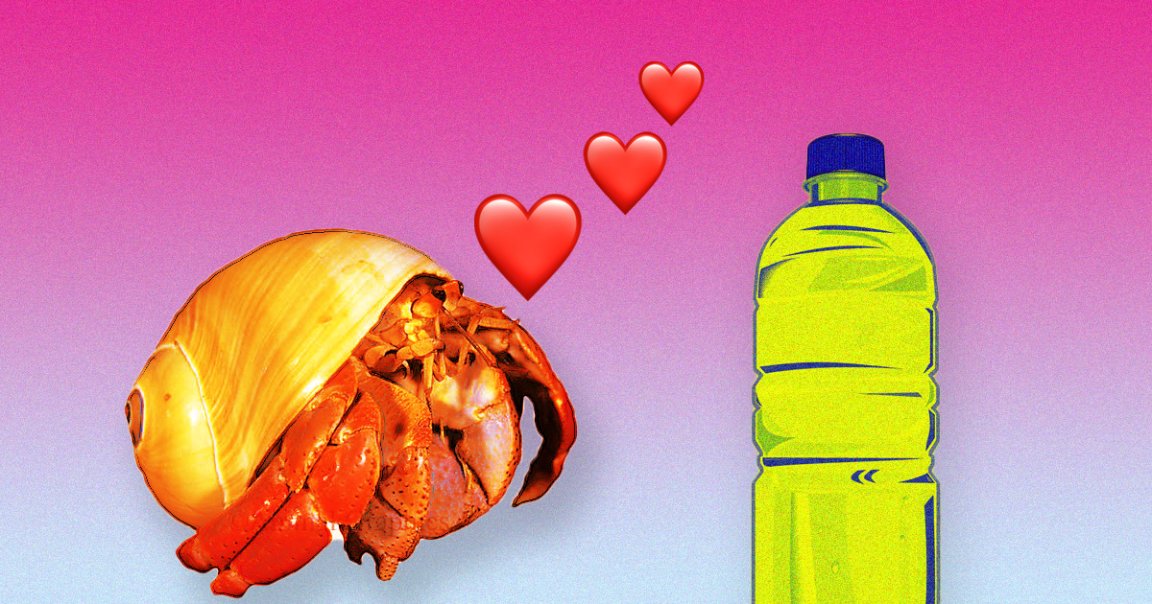
Over the past day or so, lurid headlines about the sex lives of crabs have popped up across the web.
The Washington Post: “Hermit crabs ‘sexually excited’ by plastic pollution in ocean, researchers say.”
The Week: “Plastic waste ‘sexually exciting’ crabs.”
Sky News: “Hermit crabs ‘sexually excited’ by toxins from plastic pollution.”
But as it turns out, the story may have been the product of an overenthusiastic marketing team and a trigger-happy news cycle.
It’s true that team of scientists from the University of Hull in the UK examined hermit crabs and found that they may be affected by oleamide, a chemical that leaks from plastic waste.
But while oleamide is known to be a sex pheromone for certain marine species, the team behind the study tells Futurism that contrary to the outrageous headlines, their new research does not establish that it’s affecting crabs sexually.
“Unfortunately, we had a misunderstanding with our press office,” co-author and Hull researcher Paula Schirrmacher told Futurism. “Previous work carried out at the University of Hull identified oleamide as a component of the sex pheromone bouquet of cleaner shrimp. This study, however, found that hermit crabs react to oleamide in a matter comparable to a food cue.”
In defense of WaPo‘s reporting, the original press release does appear to have been quite sensational.
“Love Island fever has gripped the nation in recent weeks, as romance and drama take centre stage in living rooms everywhere,” it read, according to Sky News, which quoted it extensively. “But far away from Casa Amor, a research team at the University of Hull has been studying a very different type of attraction, happening in waters off the Yorkshire coast. Their conclusion? Hermit crabs may be ‘sexually excited’ by an additive released by plastics in the ocean.”
Now, a revised version of the statement removes any mentions of “sexually excited” hermit crabs, as well as all other sexual content beyond noting that oleamide is known to be a sex pheromone in shrimp.
According to the researchers’ paper, published in the journal Marine Pollution Bulletin this month, the hermit grabs were indeed excited by the presence of oleamide. But while it caused their respiration rate to increase, indicating excitement, the finding was simply that the crabs were misidentifying the substance as a food source.
In other words, they got giddy about a potentially delicious snack.
“Oleamide also has a striking resemblance to oleic acid, a chemical released by arthropods during decomposition,” Schirrmacher said in the revised statement. “As scavengers, hermit crabs may misidentify oleamide as a food source, creating a trap.”
Despite the PR mishap, the research is only a small part of a much larger and far more worrisome picture. It’s true that plastic pollution in the oceans has hit a critical level. For instance, the World Wildlife Fund has found that every second marine turtle has ingested plastic. A study published last month found that plastic pollution is approaching a tipping point at which it will become impossible to reverse our unmistakable footprint on the world.
But there’s no evidence — yet, at least — that it’s driving crabs into a sexual frenzy.
Additional reporting by Jon Christian.
More on plastic pollution: Scientists Say World Is Approaching Non-Reversible “Tipping Point” in Plastic Pollution